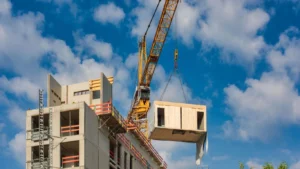
As cities grow and the demand for sustainable building solutions increases, mass timber construction has emerged as a revolutionary alternative to concrete and steel. Combining the strength of engineered wood with the beauty of natural materials, mass timber offers speed, sustainability, and modern design flexibility making it one of the most exciting innovations in architecture today.
What Is Mass Timber Construction?
Mass timber refers to large, engineered wood products made by bonding layers of solid wood together to create exceptionally strong structural panels and beams.
The most common mass timber products include:
- Cross-Laminated Timber (CLT): Layers of lumber stacked perpendicular for dimensional stability.
- Glue-Laminated Timber (Glulam): Long, laminated beams capable of spanning large distances.
- Nail-Laminated Timber (NLT): Lumber boards nailed together for floors and walls.
- Laminated Veneer Lumber (LVL): Engineered wood with high strength-to-weight ratio.
Unlike conventional wood framing, these materials allow for tall, durable, and fire-resistant buildings even up to 18 stories in some regions.

Why Mass Timber Is Gaining Global Popularity
1. Sustainable and Low-Carbon
Mass timber stores carbon dioxide absorbed by trees, making it a carbon-negative material when sourced from certified forests.
Using wood instead of concrete or steel can reduce embodied carbon emissions by up to 60%, supporting net-zero building goals.
2. Faster Construction Time
Because mass timber panels are prefabricated off-site, construction is faster and cleaner.
Buildings can rise 30–50% quicker than traditional methods, saving both time and labor costs.
3. Lightweight Yet Strong
Despite being five times lighter than concrete, engineered timber provides similar load-bearing strength.
Its lightweight nature also reduces foundation requirements ideal for urban infill or modular projects.
4. Aesthetic and Healthy
Exposed wood interiors create warm, biophilic environments that enhance occupant well-being and reduce stress.
Mass timber buildings often achieve higher satisfaction scores among office and residential users.
5. Safe and Code-Compliant
Modern mass timber systems meet stringent fire codes.
During a fire, the outer charred layer of timber protects inner layers, slowing heat penetration and maintaining structural integrity.
Applications of Mass Timber
Mass timber is being adopted across multiple industries:
| Sector | Application Example |
|---|---|
| Residential | Multi-story apartments, eco-homes |
| Commercial | Office towers, retail complexes |
| Education | Universities, schools, and libraries |
| Public Buildings | Civic centers, airports, and train stations |
| Hybrid Structures | Timber combined with concrete or steel cores |
Challenges and Considerations
While the benefits are clear, successful implementation of mass timber requires:
- Moisture control: Protect panels during transport and installation.
- Supply chain readiness: Source from certified, local mills when possible.
- Design integration: Plan early with architects, engineers, and fabricators.
- Code awareness: Check local fire and seismic regulations for mass timber allowances.
With careful planning, these challenges are easily overcome, and the long-term value far outweighs the initial setup.
Future of Mass Timber
As green building standards evolve, mass timber will play a central role in sustainable construction.
Future trends include:
- Hybrid towers combining CLT and steel.
- AI-assisted design for optimized material use.
- Circular economy models allowing reuse of timber panels after deconstruction.
Governments and developers worldwide are investing in mass timber research, pilot projects, and building codes signaling its inevitable rise as a mainstream construction solution.
Conclusion
Mass timber construction is not just a trend it’s the future of sustainable architecture.
It reduces carbon emissions, accelerates construction, and enhances human comfort, all while creating iconic, eco-friendly skylines.
As the world moves toward net-zero emissions, embracing mass timber is a smart, beautiful, and responsible step forward.






